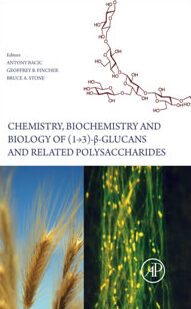Histochemical Reagents
Aniline Blue Fluorochrome for callose and related (1-3)-beta-glucans
Click here for more information
Click here for citations for this product
An analytical probe for (1-3)-beta-D-glucans (callose). Highly specific for (1-3)-beta-glucans [Evans et al. (1984) Carbohyd. Polymers 4: 215-230; Stone et al. (1984) Protoplasma 122: 191-195]. May be used for the quantitative determination of callose [Kauss (1989) Plant Physiol. 81: 171-176] and in fluorescence assays for (1-3)-beta-glucan synthase products.
Yariv Reagents for arabinogalactan-proteins (AGPs)
Click here for more information
Specific probes for the detection of AGPs in tissue sections [Anderson et al. (1977) Aust J. Plant Physiol. 4: 143-158]. May be used to detect and quantify AGPs in tissue extracts [Van Holst & Clarke (1985) Anal Biochem. 148: 446-450] and to detect AGPs in crossed-electrophoretic separations [Van Holst & Clarke (1986) Plant Physiol. 80: 786-798].
Gum Arabic an arabinogalactan-protein
Click here for more information
Gum Arabic AGP is used as a reference standard in methods involving detection, quantification and analytical analyses of AGPs from plant tissues.
Immunohistochemical Reagents
Monoclonal Antibodies (Murine)
to (1-3)-beta-D-glucan
Click here for more information
Click here for citations for this product
No cross-reactivity with (1-4)-beta-D-glucans or (1-3;1-4)-beta-D-glucans [Meikle et al. (1991) Planta 188: 1-8].
to (1-3;1-4)-beta-D-glucan
Click here for more information
Click here for citations for this product
No cross-reactivity with (1-3)-beta-D-glucans [Meikle et al. (1994) The Plant Journal 5: 1-9].
to (1-4)-beta-D-mannan and galacto-(1-4)-beta-D-mannan
[Pettolino et al. (2001) Planta 214: 235-242]
Click here for more information
Click here for citations for this product
to arabinogalactan-proteins (under licence from University of Leeds, UK)
- to arabinogalactan-proteins, terminal glucuronsyl residues (LM2)
[Smallwood et al. (1996). Planta 198: 452-459.]
Click here for more information - to arabinogalactan-proteins, beta-GlcA-(1-3)-alpha-GalA-(1-2)-Rha epitope (JIM13)
[Knox et al. (1991). Plant Journal 1: 317-326.]
Click here for more information
to heteroxylans (under licence from University of Leeds, UK)
- to (1-4)-beta-D-xylan (LM11)
[McCartney et al. (2005). J. Histochemistry & Cytochemistry 53(4): 543-546.]
Click here for more information - to heteroxylan, glucuronoxylan (LM28)
[Cornuault et al. (2015). Planta 242(6): 1321-1334.]
Click here for more information
Immunohistochemical Reagents (continued…)
Monoclonal Antibodies (Murine)
to xyloglucans (LM25) (under licence from University of Leeds, UK)
[Pedersen et al. (2012). J. Biological Chemistry 287(47): 39429-39438.]
Click here for more information
to pectic polysaccharides (under licence from University of Leeds, UK)
- to pectic (1-5)-alpha-L-arabinan (LM6)
[Willats et al. (1998). Carbohydrate Research 308(1-2): 149-152.]
Click here for more information - to branched pectic galactan (LM26)
[Torode et al. (2018). Plant Physiology 176(2): 1547-1558.]
Click here for more information - to pectic (1,4)-beta-D-galactan (LM5)
[Jones et al. (1997). Plant Physiology 113(4): 1405-1412.]
Click here for more information - to pectic unesterified homogalacturonan (LM19)
[Verhertbruggen et al. (2009). Carbohydrate Research 344(14): 1858-1862.]
Click here for more information - to pectic methylesterified homogalacturonan (LM20)
[Verhertbruggen et al. (2009). Carbohydrate Research 344(14): 1858-1862.]
Click here for more information - to pectic methylesterified homogalacturonan (JIM7)
[Knox et al. (1990). Planta 181(4): 512-521.]
Click here for more information
to extensins (under licence from University of Leeds, UK)
- to extensin (JIM20)
[Smallwood et al. (1994). The Plant Journal 5(2): 237-246.]
Click here for more information - to extensin (LM1)
[Smallwood et al. (1995). Planta 196(3): 510-522]
Click here for more information
Each of these antibodies can be used with second stage, gold- or fluorochrome-labelled rabbit, anti-mouse antibody for immunohistochemical studies.
Enzymes
(1-3;1-4)-beta-D-glucan Hydrolase from Bacillus subtilis (EC 3.2.1.73)
Click here for more information
Specifically hydrolyses beta-D-glucans containing both (1-3)- and (1-4)-beta-D-glucosidic linkages in linear sequences. Does not hydrolyse (1-4)-beta-D-glucans or (1-3)-beta-D-glucans [Anderson & Stone (1975) FEBS Letters 52: 202-207].
Substrates
Pachyman [(1-3)-beta-D-glucan] ex Poria cocus
Click here for more information
Useful as a positive control in fluoroescence microscopy studies on callose using the aniline blue fluorochrome or (1-3)-beta-D-glucan specific monoclonal antibody.

